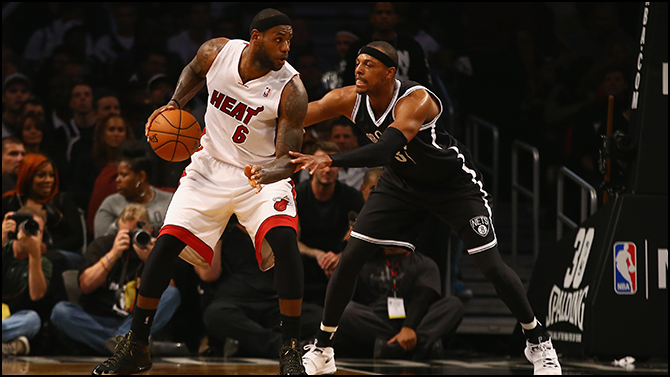By Couper Moorhead
Over the past three years, much has been made of the developmental strides taken by LeBron James and Dwyane Wade in the post. James has gone from a low-usage, high-efficiency post-up player lacking a wide variety of moves to possibly, accounting for passing and playmaking, the most complete post player in the league. And Wade tends to score more points for every one of his post-ups than almost every other guard in the league. It’s a dynamic tandem, one deadly efficient enough that Erik Spoelstra has been able to construct a large portion of his offense from the outside-in, with ballhandlers catching the ball behind the first level of defense as taller players space the floor around them.
Each player deserves credit for advancing their individual skills over the past three years, but the HEAT’s post success hinges on more than just drop-steps and hook shots. You don’t often begin a post-up with the ball in your hands, which means it’s up to someone else to deliver it where and when you want it. Throw the ball to an elite scorer on the perimeter and ask him to score if you want – a post-up requires a team.
The simplest way this manifests itself is in the where.
Here, you’ll see Dwyane Wade and Chris Bosh initiate a pick-and-roll on the right side of the floor. With players of this caliber running an action it would be easy for the other three offensive players to sit back, space the floor and watch. Instead, the HEAT are already setting up a secondary action on the weakside. The Bulls’ weakside defenders focus on one side of the floor while another option develops right in front of them.

“[Mario] now sees that LeBron is taking the post,” Spoelstra said. “He doesn’t make a bad play by throwing it when he’s not quite open. The right play is now, ‘It’s not my play, it’s now Dwyane’s responsibility to make the entry pass’.
“[Mario] reads that and throws it to Dwyane. LeBron is able to seal, fight for that paint position and as it goes to Dwyane and he’s able to make that play. The next level of that [possession] is that if Dwyane can’t make the play, [Mario] then cuts through and here comes Shane and now Shane gets an opportunity [to make the play].”
Angles and timing is all it is, but its taken years to create such a fluid offense. Watching film of possessions like this, Spoelstra commented that they’ve had to devote quite a bit of time to the details. Some plays can be made on instincts, but you have to work on screening with a purpose, sealing your man on the high side of the floor to open up the wing entry pass and working the triangle passing to find the best angle all while reading the other defenders on the floor to make sure there’s no weakside help on its way.
Working the details gets everyone on the same page, and that earns a level of comfort. It’s important to note that these often aren’t specific play calls that Spoelstra makes from the sidelines. By working these situations in practice and building up trust, Spoelstra has built a system that doesn’t require micro-management. When the opportunities present themselves, the players can work what they know not what they’re being told.
The results, over and over again, speak for themselves.

“It’s five guys working together to get a deep catch for the best available shot. That’s takes a lot of work and trust and habits. Just drilling it and making the proper reads. This is the culmination of three years.”
Three years spent building towards something special, and a year after setting the league record for effective field-goal percentage – accounting for the value of three-pointers – Spoelstra has his team on pace for one of the best and most balanced offensive systems we’ve ever seen.
